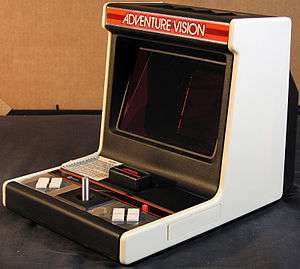Entex Adventure Vision
Adventure Vision is a cartridge-based video game console released by Entex Industries in either August or October 1982. The monitor, game controls, and computer hardware are all contained within a single portable unit. The LED monitor can only display red pixels. Four games were released, all of which are arcade ports.
 | |
| Manufacturer | Entex Industries |
|---|---|
| Type | Video game console |
| Generation | Second generation |
| Release date | 1982 |
| Discontinued | 1983[1] |
| Units sold | 50,757[1] |
| Media | ROM cartridge |
| CPU | Intel 8048 @ 733 kHz |
| Predecessor | Entex Select-A-Game |
Adventure Vision was Entex's second-generation system following the Entex Select-A-Game, released a year earlier in 1981.
Description
Control is through a single multi-position joystick and two sets of four buttons, one on each side of the joystick, for ease of play by both left- and right-handed players. Rather than using an LCD screen or an external television set like other systems of the time, the Adventure Vision uses a single vertical line of 40 red LEDs combined with a spinning mirror inside the casing. This allows for a screen resolution of 150 × 40 pixels. The mirror motor draws a great deal of power from the batteries, which can be avoided by using the built-in AC adapter.
Games
Entex released four Adventure Vision games:
- Defender, based on the Williams Electronics arcade game of the same name
- Super Cobra, based on the Konami arcade game of the same name
- Turtles, based on the Konami arcade game of the same name (similar to Pac-Man)
- Space Force, based on the Venture Line arcade game of the same name (similar to Asteroids)
Technical specifications
- CPU: Intel 8048 @ 733 kHz
- Sound: National Semiconductor COP411L @ 52.6 kHz
- RAM: 64 bytes (internal to 8048), 1K (on main PCB)
- ROM: 1K (internal to 8048), 512 bytes (internal to COP411L), 4K (cartridge)
- Input: 4 direction joystick, 4 buttons duplicated on each side of the joystick
- Graphics: 150x40 monochrome pixels
Legacy
A similar display technique combining red LEDs with a moving mirror was used by Nintendo in the 1995 Virtual Boy.
On March 31, 2013 at the Revision demoparty, the first ever homebrew/demo ROM for the system was demonstrated[2] by MEGA - Museum of Electronic Games & Art. MEGA also released[3] the source code for the demo as well as all development tools.
The system is supported by the MESS emulator and AdViEmulator.[4]
See also
References
- Forster, Winnie (2005). The encyclopedia of consoles, handhelds & home computers 1972 - 2005. GAMEPLAN. p. 53. ISBN 3-00-015359-4.
- Revision 2013 demoparty entry on pouet.net
- Open Source Adventure Vision development kit including demo source code
- AdViEmulator, a specialized Open Source Adventure Vision emulator
External links
- Video Game Console Library
- TheGameConsole.com
- Handheld Games Museum
- AdventureVision.com
- Mini-Arcade.com
- Games Database.org
- Picture and some information about Entex Adventure Vision (Dutch language)
- Information about the first Adventure Vision demo and the making-of
- Adventure Vision games playable for free in the browser at the Internet Archive Console Living Room.